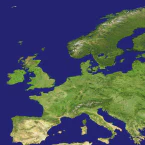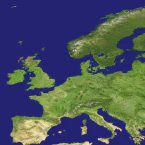Top 10 Must-Visit Castles Across Europe

Experience the Grandeur: Top 10 European Castles You Must Visit
Imagine stepping into a world of regal splendor, surrounded by the majestic remnants of a bygone era. Europe’s castle-speckled landscapes have this uncanny ability to transport us back in time, while simultaneously challenging our imaginations to conjure the mesmerizing stories of royals, knights, and epic battles that once occurred within their walls. Here is a list of the top 10 amazing European castles that are a must-visit for any historical or architectural enthusiast.
10. Palacio de Pena, Portugal
Perched on a hill in the Sintra Mountains, Pena Palace springs to life as a blaze of color amidst a dense forest. This palatial fortress is an exemplar of 19th-century romanticism, presenting an eclectic amalgamation of architectural styles nestled within a luxuriant, labyrinthine garden. Strolling around, you’d be forgiven for thinking you’ve wandered into a fairy tale.
The first structure on this hilltop was a chapel inspired by a vision of the Virgin Mary. This was followed by a monastery, around which King Ferdinand II built his extravagant summer palace. Visitors can still see the original furniture, stuccos, and trompe-l’oeil murals within the restored interior, offering a glimpse into the lavish lifestyles of the past.
9. Boer Hohenwerfen, Austria
Situated at the foot of the Alps, ancient Hohenwerfen Castle watches over the serene market town of Werfen in Salzach Valley. This imposing medieval fortress was built in the 11th century amid political turmoil, initially serving as a watchtower against the forces of Holy Roman Emperor Henry IV. Over time, the castle transformed from a prison to a hunting retreat, and today it stands as a museum. Visitors can delight in a spectacular falconry show, complete with historic costumes and hunting music, bringing the past to life.
8. Chateau de Chillon, Switzerland
Chillon Castle, often featured on postcards, captivates with its magnificent lakeside setting. But it’s not just about the breathtaking view. The 13th-century island fortress has a rich history that involves daring defiances and famous prisoners. Nowadays, its medieval towers, halls, and dungeons have transformed into delights for visiting tourists, a stone’s throw away from the picturesque town of Montreux.
7. Bran Castle, Romania
Bran Castle, intriguingly nicknamed Dracula’s Castle, sits beneath the sky, its red rooftops daring travelers to approach. Inside the castle, you can explore a warren of narrow passageways and royal chambers, decorated with original furniture and fittings, adding an authentic feel to your adventure. While the castle’s connections with Bram Stoker’s Dracula or the historical figure Vlad the Impaler may be tenuous, it nonetheless provides a spellbinding sight.
6. Tower of London, England
There is a certain incongruity to the medieval Tower of London, a Norman fortress residing in the heart of a bustling modern city. Its blood-soaked history, intertwined with deposed monarchs, lost princes, and infamous executions, adds a fascinating albeit grim allure. The castle’s resident ravens have become an integral part of the attraction, their departure said to portend the fall of Britain.
5. Prague Castle, Czech Republic
The world’s largest ancient castle, Prague Castle, looms over the Vltava river, a silent witness to the passage of kings, emperors, and presidents. Its grand architecture incorporates a myriad of styles, from the Romanesque St. George’s Basilica to the Baroque New Royal Palace. Lording over everything is the awe-inspiring Gothic St. Vitus Cathedral.
4. Alambra, Spain
Designed as a ‘paradise on earth’, the Alambra in Granada does not disappoint. This tranquil fortress presents a visual symphony of geometric carvings, stuccos, and mosaics—a testament to the brilliance of Moorish architecture. In this UNESCO World Heritage Site, you can stroll through gorgeous gardens, where nightingales flit among the trees, and marvel at the splendid Palatios Natharias.
3. Château de Château-So, France
Tucked away in France’s lush Loire Valley, the Château de Château-So sits splendidly over the shimmering waters of the river Cher. Affectionately known as Le Château des Dames, this enchanting castle is a testament to the influential women who shaped its unique architecture and reputation.
2. Edinburgh Castle, Scotland
Standing on a volcanic outcrop of black rock, the often-besieged Edinburgh Castle broods over the city’s Old Town. It has played a significant role in Scottish history, particularly during the Wars of Independence. Nowadays, museums occupy the interior, inviting visitors to learn more about Scotland’s turbulent past.
1. Schloss Neuschwanstein, Germany
Last but not least, we arrive at King Ludwig II’s Schloss Neuschwanstein, a castle that seems straight out of a fairy tale. Its dramatic towers and masterful murals and frescoes depicting mythological scenes lend it an air of enchantment. This castle is a love letter to a bygone era, a symbol of a ruler’s passion that continues to captivate visitors from around the world.
Conclusion
Venturing through the regal doors of European castles, we are privileged to explore the fascinating stories that continue to echo within their hallowed halls. These time-worn edifices present a tangible connection to our shared history, their crenellated ramparts and ornate towers providing a captivating backdrop for the unfolding narrative of human endeavour and ambition.
Every castle has its unique charm and character, each one reflecting the distinctive era, culture, and context of its creation. From the romantic splendor of Palacio de Pena in Portugal to the enchanting Château de Château-So in France, these castles serve as more than just architectural marvels. They are bridges to the past, bearing witness to the rise and fall of empires, to tales of courage, treachery, romance, and tragedy that have shaped the course of history.
However, the allure of these castles is not solely bound by the echoes of the past. These majestic structures continue to inspire us, lending lessons to modern life. The endurance and toughness of the castles remind us of the permanence that lies within transience, inspiring us to build our own legacies that can withstand the test of time.
Moreover, these castles foster a sense of shared identity and culture. Their collective narratives weave a complex tapestry of European history, reflecting a rich diversity of traditions, beliefs, and styles. This shared heritage can foster a sense of unity and cohesion, inspiring us to appreciate and respect our shared human story.
So, whether you’re an avid history enthusiast, an architectural aficionado, or a curious traveler looking for a unique journey, a visit to these European castles can offer you an improving and unforgettable experience. It’s a chance to step back in time, to marvel at the grandeur and artistry of past epochs, and to draw inspiration and wisdom from the echoes of history.
In conclusion, a journey through these enchanting European castles is more than just a voyage into the past; it’s a voyage into the heart of our shared human experience, providing us with invaluable perspectives that can inspire us to shape a better future. With every castle visit, we don’t just explore stone and mortar edifices; we delve into the narratives of the human spirit, etched in stone, that continue to captivate, inspire, and unite us.
1. Are these European castles open year-round for visitors?
While most of the castles listed are open to visitors throughout the year, some may have seasonal closures or adjusted opening hours depending on the time of year. Therefore, it’s advisable to check the official websites of these castles or contact their information centers for the most accurate and up-to-date visitor information.
2. Can I take a guided tour at these castles?
Yes, many of these castles offer guided tours which can greatly improve your visit. These tours, often available in multiple languages, provide in-depth insights into the history and architectural nuances of the castles. Some even offer special themed tours focusing on specific aspects of the castle’s history or its prominent inhabitants.
3. Are these castles family-friendly and accessible for people with mobility issues?
Most of these castles have made efforts to become more accessible and family-friendly. They often provide amenities like lifts or ramps for visitors with mobility challenges and activities or workshops designed specifically for children. However, due to the historical nature of these sites, some areas may be difficult to access for those with mobility issues. It’s best to check with each castle for details on accessibility.
4. Are there restaurants or cafés available at these castles?
Many of these castles host on-site cafés or restaurants, allowing you to enjoy a meal or refreshments while soaking in the historic surroundings. Some even offer the unique experience of dining in rooms that were once used by the castle’s historic inhabitants. However, the availability and hours of these facilities may vary, so it’s recommended to check ahead.
5. Can I take photographs inside these castles?
While photography is typically allowed in the outdoor areas of these castles, the rules regarding photography inside can vary. Some castles allow non-flash photography throughout, while others restrict photography in certain areas to help preserve the delicate interiors. Always look for signage or ask a staff member if you’re unsure about the photography policy.









